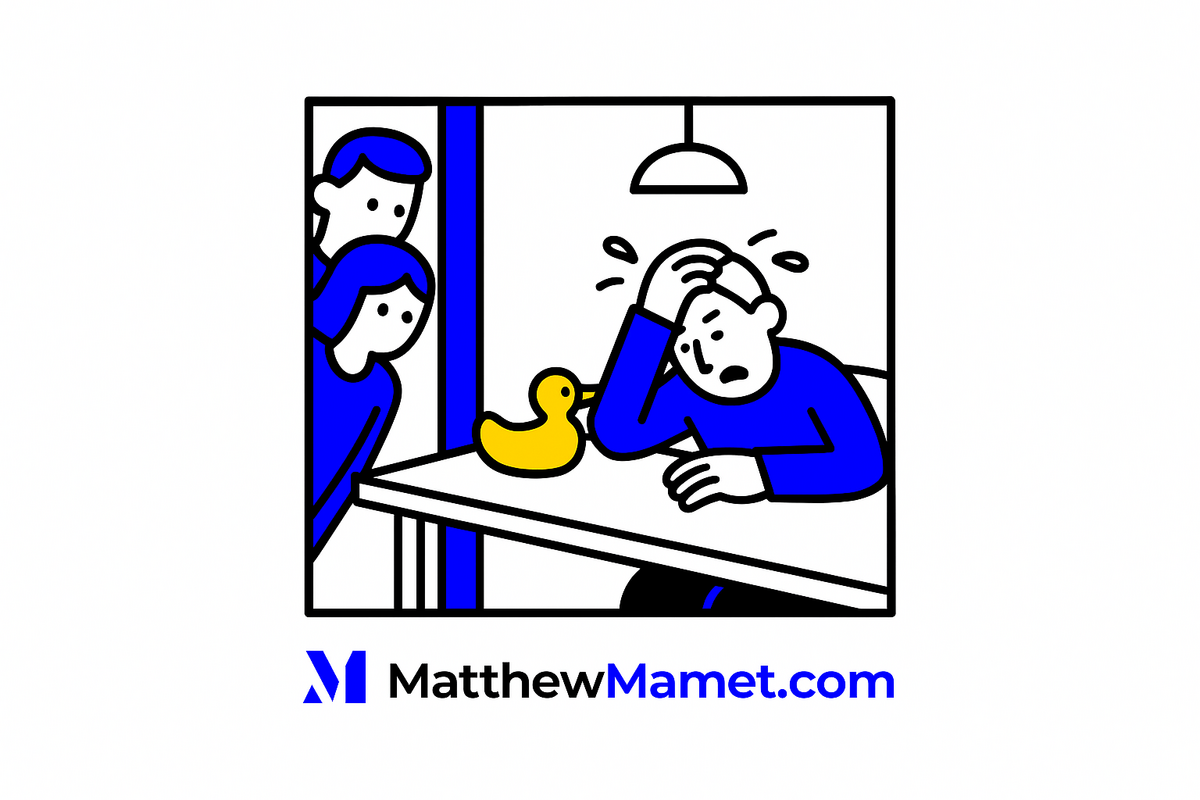Table of Contents
The time I nearly paid a branding agency $20K to rename... nothing
What is rubberducking, really?
The clarity effect: Saying it out loud changes how you think
The method: How to rubberduck well (with or without a duck)
Real examples: Where rubberducking saves the day
The time I nearly paid a branding agency $20K to rename... nothing
A few years back, one of my teams called an emergency meeting. We had a messaging problem - or so we thought. Conversions were dropping. Bounce rates rising. Panic mode.
We started throwing around new positioning ideas. One marketer pulled up A/B test data. Someone from leadership said maybe the brand name was the issue. That snowballed into an existential debate - new pricing? New audience? Rename the company?!
I almost hired an expensive branding agency that week.
Then a junior dev did something brilliant. She grabbed the office rubber duck, walked to the whiteboard, and said: “I’m going to explain what’s wrong to the duck.”
She talked through the problem like she was teaching it to a kindergartener. Why our landing page was confusing. What users expected. What "success" looked like. By the end of her five-minute monologue… we all saw it.
The CTA copy sucked. That was it.
We rewrote two lines, tested it, and bounce rate dropped 30%. Panic over.
That stuck with me.
What is rubberducking, really?
It’s a simple - and weirdly powerful - method of troubleshooting. You explain your problem out loud, step-by-step, to an inanimate object (usually a duck). The process of articulating the issue forces clarity.
Where does it come from? Software engineering. Devs use it to debug. But here’s the thing:
Rubberducking isn’t just for code. It’s for everything.
Struggling with your roadmap? Walk it through with your duck. Confused by why users aren’t activating? Talk it out. Churning customers? Duck it.
It sounds silly. It absolutely works.
The clarity effect: Saying it out loud changes how you think
Thought feels fast. Talking forces slow.
Your brain can hold disjointed ideas all day - partial thoughts, vague beliefs, gut feelings. When you say it out loud? You confront how fuzzy your thinking really is. It's like doing a brain defragmentation.
You'll discover:
- You’re solving the wrong problem
- You skipped a logical step
- You’ve assumed something without proof
- Or the answer was obvious, but hidden behind noise
Ever feel like explaining something to a new teammate unlocks the solution for you? That’s rubberducking. Except you don’t need the teammate. Just your words.
This is exactly what happened in one of my coaching sessions with a VP of Product. She laid out her complaints about her team, but as she explained it out loud - no prompting - she realized she hadn’t clearly defined success in two months. It turned into an alignment plan, not a firing conversation.
Ready to drive more growth & achieve bigger impact?
Leverage my 25+ years of successes and failures to unlock your growth and achieve results you never thought possible.
Get StartedThe method: How to rubberduck well (with or without a duck)
Here’s the play. It’s not complicated, but there’s a right way to do it.
1. Define the “listener”
Yes, you can use an actual duck, a sticky note, a mirror, or a text message to yourself. Doesn’t matter. What matters: behave as if that thing doesn’t know anything yet. It’s a student, not a search engine.
2. State the problem like you’re teaching it to a 10-year-old
Job One: be clear. What’s happening? What’s not happening that you want to see? Where did it diverge from the expected?
3. Tell the full story, out loud, step-by-step
No skipping. No summarizing. Imagine you’re pitching the problem on Shark Tank. The minute you fudge a detail or jump ahead in logic, call it out.
4. When stuck, ask questions back at yourself
Examples:
- “What assumption am I making here?”
- “Where could this chain break?”
- “Has this actually happened before?”
- “Is this a product or a people problem?”
5. Then, decide what you’ll test
Not solve. Not "fix." Just test. The rubber duck doesn't care about ego or getting credit. It helps you pick one small, smart action to try next.
Pro tip? If you’re a manager, teach your team to do this before they escalate problems. It saves hours.
Real examples: Where rubberducking saves the day
I’ve coached execs and product teams through sticky problems using this approach. Here's where it routinely makes a difference:
Marketing isn’t converting → Look at the full value chain
A growth lead recently told me email wasn’t working anymore. CTRs were tanking. Mid-rant, she paused and realized: many emails were pointing to pages without value-first content. The email wasn’t the problem. The content was lazy. That insight turned into a framework for smarter growth decisions.
Product has no adoption → Talk through why people would care
In another case, I asked a founder to "pitch their product to the duck.” Three minutes in, they realized they couldn’t explain the difference between Features A and B. The product wasn’t sticky because it was confusing as hell. We re-sequenced the onboarding.
You’re making no progress → Rethink what progress looks like
A stuck team can go in circles for weeks. One team I advised hit a wall with a key initiative, and the PM was in their own head. I asked them to talk through what success looked like next quarter, month, and week - aloud, no notes. The problem? They never defined success past metrics. We reframed it into testable outcomes.
Ready to drive more growth & achieve bigger impact?
Leverage my 25+ years of successes and failures to unlock your growth and achieve results you never thought possible.
Get StartedWhen to duck: Common team moments to apply it
Rubberducking doesn’t need to live in your shower thoughts. Use it on purpose with your team.
Here are five moments where it’s wildly effective:
| Situation | What You Hear | How to Use the Duck |
|---|---|---|
| Product scope creep | “Well, we also promised to build…” | Ask: what’s the core problem? Say it to the duck. |
| Team stuck in meetings | “We’ve had 3 brainstorms, no decision.” | Someone present the issue to the duck. No interruptions. |
| Everyone feels overwhelmed | “It’s just too much.” | Walk through every deliverable to the duck. Spot duplication. |
| Misalignment with stakeholders | “They don’t get it.” | Explain their priorities to the duck. Are you sure it’s them? |
| Metrics not moving | “We changed the CTA again.” | Talk through the funnel end-to-end. Where’s the leak? |
Want a formal tip? Build it into retros or work sessions: “Okay, rubberduck time. One person explains the issue aloud, uninterrupted.”
Yes, it's about problem-solving. But it’s also about understanding your own reactions.
Rubberducking helps with:
- Unpacking frustration before it leaks onto your team
- Avoiding reflexive blame
- Identifying when fear is driving your decision, not facts
I had a CEO recently convinced a competitor was about to eat their lunch. We rubberducked the threat. By the end, it was just fear of falling behind. We focused on learning instead of reacting. Fewer power grabs, more collaboration.
When you're stuck emotionally, try this: name what you’re feeling, and tell the duck the story you’re telling yourself. That tiny moment can shift your mindset before it messes up your next call.
Ready to drive more growth & achieve bigger impact?
Leverage my 25+ years of successes and failures to unlock your growth and achieve results you never thought possible.
Get StartedYou can bake this into your product planning process, your onboarding, even your Slack rituals.
You don’t need the duck. You need the pause.
Rubberducking works because it forces you to step outside yourself. It makes you listen to your own logic - and catch when it’s broken. It builds better products, faster cycles, stronger teams.
Whether you do it with a yellow duck, a sticky note, or a voice memo doesn’t matter.
Just don’t keep thinking your way through a mess. Talk your way through it.
And while you’re at it, make it weird. Name your duck. Put it on your desk. Give it employee of the month. Let it break your stuck loop.
Because let’s be honest - most “big problems” aren’t. They’re badly explained, half-baked ideas held together by hope.
Give them five minutes with a duck. Then go actually fix it.
Ready to drive more growth & achieve bigger impact?
Leverage my 25+ years of successes and failures to unlock your growth and achieve results you never thought possible.
Get Started



